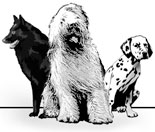February 26, 2008 was a day I had been looking forward to for quite some time. After spending a few years hoping to have the opportunity to join a student at a consultation with Dr. Karen Overall, and never finding such a chance, I decided to take my own dog to her for a consultation!
Dr. Overall is a board-certified veterinary behaviorist and a diplomate of the American College of Veterinary Behaviorists; one of only 46 in the world. She worked for years at the University of PA Veterinary School where she ran the Behavior Cinic, but is currently with the Psychiatry department. I consider her THE guru for behavioral issues, and THE person to go to with a dog who might need medication intervention along with behavioral treatment. (I have recently found another vet who is more local and does behavioral cases, too, and this is thrilling!)
So on a snowy, rainy morning, Bing and I drove down to my friend Leslie McDevitt’s house to pick her up for the ride to Karen’s house. I had already filled out and sent in my 36-page evaluation form, along with video footage of Bing’s behavior in the car, both crated and not crated. I described in great detail his early development and training, our home environment, the events which I believe triggered his fear response toward hands approaching him, the amount and type of food he eats, the exercise he gets, etc. I brought with me a bag of treats and his muzzle (which I was pretty sure we wouldn’t need, but just in case…). I was unsure but interested in what Bing would do with a different person in the passenger seat of the van. He’d met Leslie a bunch of times already, but it had been a while. His behavior in the van was more relaxed than I anticipated (he even laid down briefly on the ride to Philly) and Leslie hardly got to see any anxious behavior. Bing even put his head in her lap once or twice!
The first thing Karen said to Bing when he walked into her house was, “Man! You are one weird dog!” to which I howled with laughter and said, “Thank you!” As if that wasn’t validating enough, she then said, “This is not a training issue.” WHEW!!!
Karen, Leslie and I spent the next five hours talking behavior. Bing spent quite a bit of time walking around Karen’s house and eventually put himself down for a cozy nap under a beautiful old desk in the room we were using. No stress going on there! Dr. Overall concluded that there were some organic and very early developmental issues which contributed to Bing’s current state, namely, that he was one of a very small litter, and that his mother’s grandmother also produced a very small litter at the same time (same day, actually). They were litters of 5 and 4, and one litter had a stillborn and the other litter had a “failure-to-thrive” puppy. She pointed to research which suggests that there was something genetic going on here that is not preferable. In addition, in the fall, I had received a report from a trusted source about which I had been previously unaware that Bing’s mother didn’t particularly care for her puppies. It’s not that she mistreated them, but rather that she didn’t wish to interact much with them. This withdrawal on the part of the mother results in the lack of some early stimulation, control and socialization which can have lasting effects. Happily, some of this effect may have been mediated by the fact that there were other pups and another dam around.
One more symptom which helped to accurately diagnose him is his sound sensitivity. Bing has always taken the sound of barking dogs very seriously. Barking is often an alert, and he usually takes that alert to heart. The first time he heard clapping at a rally trial, he tried to leave the building. His first fireworks exposure at age 4 months resulted in him running frantically around a friend’s back yard, trying to get away…the fireworks were miles away. Thunderstorms did not initially bother him, but now they do. Even the sound of Pete working on a closet upstairs created ‘that look’ in Bing’s face that indicated his belief that the world was coming to an end. The fact that his sound sensitivity is getting worse, not staying the same or getting better, helped Dr. Overall with her diagnosis.
While I have always felt that the events in his early puppyhood with me were triggering events for his current and ongoing behavioral issues (the double ear infection and subsequent treatment and the hose spray-in-the-eye event and its subsequent treatment, as well as the excitement in and near the car with Acacia and the tennis ball), Dr. Overall assured me that these were not the only precipitating events in this case. There has to be some organic/genetic predisposal toward finding such events necessary to set off an anxiety response. This is what has happened in Bing’s case. His nervous system was predisposed to find these events very stressing, and he is biochemically not able to handle these things. Dr. Overall diagnosed him with Generalized Anxiety Disorder.
While Bing, at a glance, may seem like a fabulous dog (which he is, but he is work!), it is due largely to the sheer amount of consistent and positive training that he has been able to cope with things like going across country, learning new things, and being able to rack up so many ribbons and titles in rally obedience. Had he not received so much structure, his world would have been entirely different. Hearing this coming from the mouth of Dr. Karen Overall was one of the most validating and guilt-relieving statements I’d ever heard. And now, we have the opportunity to make even greater strides!
Bing started fluoxetine (generic Prozac -- a Selective Serotonin Reuptake Inhibitor or SSRI) the next day, and for acute situations (i.e., visits to the vet) he gets Xanax (a Benzodiazepine) until we are able to make more progress with him. My work is far from over. He has been on the Prozac for four weeks now, and it can take up to 6-8 weeks to really see a difference. We already see tons of small changes in Bing, and aside from general training stuff, I have not really worked him much. Now that the Prozac has started to affect changes in Bing’s neuronal functioning, I need to start doing the Relaxation Protocol again….finish the program up in my living room, then do it all over again in the training room, then move it to the car. We can also do the relaxation protocol in conjunction with hands being near him and at rally trials, agility trials, in the baby’s room…the choice of locations is endless.
Dr. Overall explained to me that Prozac actually creates new receptors in the neuronal endings (the other end of the synapse from where the serotonin is originating), so that his brain can utilize the serotonin more efficiently. As he’s able to do this, his perception of the world can change even more than it has already, in a good way.
Within a week, I began to see things like better focus on me at rally trials, the willingness to tolerate brushing in short spurts (I have concluded that he finds brushing physically painful), and a marked decrease in humping behavior with other dogs. While he was always friendly with dogs, he has always humped other dogs in play. In the past year it has become even more intense, occasionally leading to a confrontation. But now, we see that it has nearly ceased altogether, leading me to conclude that his humping behavior was social anxiety…wanting to interact but not being sure what else to do. As his anxiety begins to diminish, he has less need for humping. He now is more likely to appropriately sniff and play, or walk away and parallel sniff. So far, I haven’t seen him vomit up his food since starting the Prozac (this was a weekly occurrence), and we have been able to successfully call him away from really distracting and exciting things, like dogs in the distance!
He solicited petting from Sue, my other trainer, last week while we were watching video of our most recent rally trial. He approached her and put his head under her hand. She was able to pet him for about 4-5 seconds before he began to stiffen up. But it was his call; he had the opportunity (and took it) to walk away, and then returned for more.
Yesterday, against my better judgment, I had to take him to the vet in my new car (NOT THESE SEATBELTS!!!). He LOVED it…he could sit there and look around, out all of the windows…something he couldn’t do in the Element or in the van. He made no attempt to mouth or chew anything, and on the way home, despite the trauma of having been muzzled, having blood drawn and having Dr. Draper pet him and feel him up, he LAID DOWN during the drive!! And Acacia only had to yell at him once!
There are tons of other small changes we’ve been noticing, and I’ll be sure to report on them as we go, but suffice to say I’m exuberant over this entire development! For a person who is REALLY not into drugs, I’m glad I made the exception for this little doggie….
Ali
Comments about this blog, email pete@e-production.net (your comments may be posted).
Return to the Main Blog Page.
Send email to Ali Brown
click on the arrow to play.
to her seat.
Bing Blog 38



